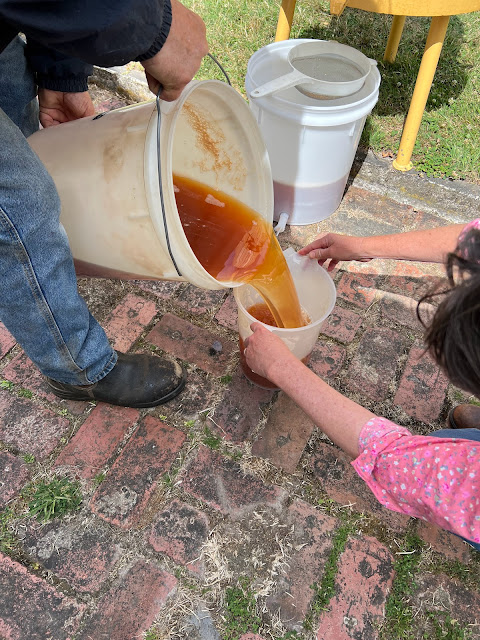Vista Bella day ...
Vista Bella apples
Vista Bella is a very early season apple that is crisp, juicy and distinctly tart. Despire the fact that the variety was developed at Rutgers University in New Jersey in the mid 1950s it takes its name from the fact that it is also grown with some success in the Guatemalan highlands. Vista Bella apples ripen in mid-January making it the earliest apple of the season, but they also do not keep very well and so are popular with cider makers. When the apples ripen cider makers get together to press the fruit and get the first seasonal batch of cider brewing. This weekend was our first formal Vista Bella day and on Sunday we gathered at a local cider maker’s place, together with 8 others, and set about making cider using the freshly picked Vista Bella apples.
The basic steps involved are as follows.
1. Washing. The apples are collected from a large apple box, placed in buckets and then dumped into a container of water. After a brief rinsing the apples are drained in a large plastic colander.
2. Pulping. The apples are tipped straight from the colander into a fearsome looking machine that mashing them up pretty thoroughly. Once tipped into the funnel the apples pass through a series of rotating blades and emerge as pulp which is collected in a plastic container lined with a porous bag.
The masher setup
Collecting the pulp
3. Pressing. Once the bags are filled with pulp they are placed into an apple press. The bags are optional but they are extremely helpful as they stop little bits of apple going everywhere - something you only fully appreciate at the cleanup stage.
The queue for the apple press
The apple press itself is a beautiful piece of equipment. There is a heavy base plate to catch the juice and funnel it into a container; a lovely wooden barrel to hold the fruit and a ratchet device for pressing a wooden plate onto the pulp in order to extract the juice. It looks and feels a bit like a medieval instrument of torture but it is ruthlessly efficient at extracting juice. The dry pulp is then taken out of the wooden barrel - a feat made easy because of the bags - and deposited in a large container for transportation to the neighbours' cattle troughs. Nothing gets wasted in this process!
The apple press
Cattle fodder
4. Decanting. Once the juice has been extracted from the pulp it is poured into demijohns where the fermentation will take place. In preparation for the big day we had sterilised our 5 litre demijohn ready to receive the juice.
The amber nectar
A full demijohn
5. Fermenting. At this stage the juice is ready for fermentation. Some of the cider makers use only the natural yeasts of the apple juice for fermentation while others add about half a teaspoon of champagne yeast to a 5 litre container. As Vista Bella is an early season apple and therefore low on sugar we opted to add some yeast. The demijohn is then sealed with an airlock, that allows the gas (CO2) generated by fermentation to escape without letting any air in, and kept in a place where ideally the temperature is more or less constant somewhere between 16 and 22 degrees Celcius.
Adding the yeast
The magic at work
We have found that watching bubbles of CO2 escape through the airlock is a pretty addictive spectator sport. Anyway, in about 4 to 5 weeks time the next stage of the process will begin and in roughly 2 months time we might even crack open our first bottle of home made apple cider!
6. Cleaning. This is the point where you engage the host in earnest conversation about the whole process. Asking seemingly erudite questions about the relationship between the initial specific gravity of the apple juice and the alcohol content of the final product as well as the pros and cons of various hydrometers will usually waste about half and hour quite easily. You can then look around in amazement and appreciate just how easy the cleaning the process actually is.
7. Tasting. The host and chief cider maker should now disappear into his cellar and reappear with armloads of bottled cider to taste over a communal lunch of bread, cheese and assorted pickles. This is the most time consuming of all the steps but is extremely pleasurable.
Cath and I had an excellent day chatting to our fellow inhabitants of the Huon, all of whom share a passion for making apple cider. Here is hoping that the product we end up with tastes half as good as the that which we imbibed over lunch ...












Comments
Post a Comment